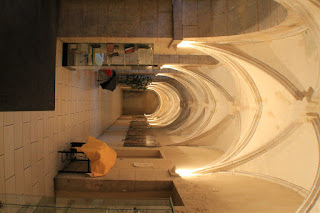 |
| West Facade, exterior (Royal Portal) |
 |
| West Facade, interior (Royal Portal) |
On Thursday I ventured to Chartres (Shar-truh) to visit the famed Gothic Cathedral,
Cathedrale Notre-Dame de Chartres, and to take a tour lead by English scholar
Malcolm Miller, who has been studying the cathedral and sharing his knowledge through lecture tours for over half a century. The tour started in the royal portal where Malcolm 'read' us the stories in the glass windows located between the two towers. What is most outstanding about this cathedral, the fourth recorded on this location, is that it was constructed in 66 years. Many of the children that watched the church burn in 1194, helped rebuild the cathedral and also attended the dedication in 1260. The church had been a important shrine for pilgrims to visit because it housed the torn veil or tunic (birthing gown) that was supposedly worn by the Virgin at Christ's birth. The church had acquired the relic as a gift from Charles the Bald, the grandson of Charlemagne. It was believed that the saints interceded through their earthly relics. What lead to the church being rebuilt so rapidly was the fact that after the ashes has cooled the veil was found in the crypt unharmed and it was taken as a sign that 'Our Lady' wanted a new church built on this location. Recent dating of the garment and the weaving technique date the cloth to the first century A.D.
I also took a separate crypt tour with a guide named Annie, who had one of the English ladies translate what she was saying so that those of us who do not speak French were able to gain more knowledge about the building and artifacts.
 |
| 12th century mural in Fulbert's crypt |
|
|
|
|
|
|
 |
Crypt
|
|
|
|
|
|
|
|
I dinned at
Le Serpente where I
enjoyed soupe de legumes and mouse de chocolate, where the interior is
covered by a large collection of tea pots. I spent the night at
Hotellerie Saint Ives,
located behind the cathedral. The building is a renovated monastery
with Meditative garden areas, which were unfortunately closed due to all
the rain. From my window I could view a garden version of a labyrinth.
 |
| Hallway of Hotellerie Saint Ives |
 |
| Hotellerie Saint Ives garden |
 |
| Labyrinth |
This morning I returned to the Chartres Cathedral because they remove the chairs in order for pilgrims and tourists to view and walk the labyrinth, which is the largest surviving labyrinth from the Middle Ages dating from c.1200. Many were destroyed in the 17th and 18th centuries because the purpose was no longer understood even by the clergy. Modern day pilgrims still walk to Chartres from Paris, yesterday Malcolm told us of a group on a recent pilgrimage that said they could see the towers of the Cathedral for two days before their arrival on foot. Traditionally the pilgrims would start by crawling in the church from the west, continuing on bended knee while meditating until they reached the center where it was thought they would meet God.
I also visited the
Centre International du Vitrail (International Stained-Glass Centre) which house a permanent exhibition explaining the cathedral's stained-glass windows. They had a really nice guide in English that explained all of the glass from Chartres. Currently downstairs in the Loens Gothic cellar, c. 1200, is a outstanding display of contemporary stained-glass pieces.



























